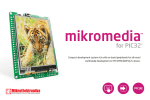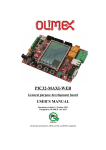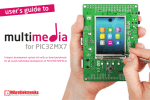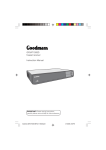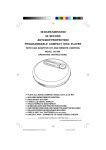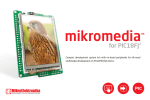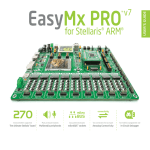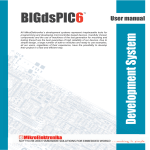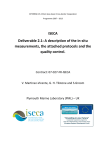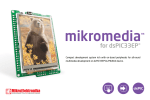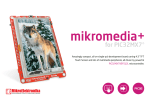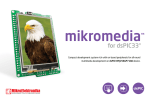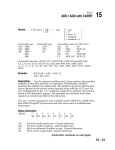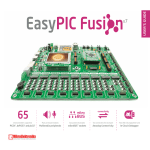Download LV32MX v6™ - MikroElektronika
Transcript
All MikroElektronika´s development systems represent irreplaceable tools for programming and developing microcontroller-based devices. Carefully chosen components and the use of machines of the last generation for mounting and testing thereof are the best guarantee of high reliability of our devices. Due to simple design, a large number of add-on modules and ready to use examples, all our users, regardless of their experience, have the possibility to develop their project in a fast and efficient way. User manual Development System If you have any questions, comments or business proposals, do not hesitate to contact us at office@mikroe.com If you are experiencing some problems with any of our products or just need additional information, please place your ticket at www.mikroe.com/en/support If you want to learn more about our products, please visit our website at www.mikroe.com LV32MX v6 ™ DISCLAIMER All the products owned by MikroElektronika are protected by copyright law and international copyright treaty. Therefore, this manual is to be treated as any other copyright material. No part of this manual, including product and software described herein, may be reproduced, stored in a retrieval system, translated or transmitted in any form or by any means, without the prior written permission of MikroElektronika. The manual PDF edition can be printed for private or local use, but not for distribution. Any modification of this manual is prohibited. TO OUR VALUED CUSTOMERS I want to express my thanks to you for being interested in our products and for having confidence in mikroElektronika. The primary aim of our company is to design and produce high quality electronic products and to constantly improve the performance thereof in order to better suit your needs. Nebojsa Matic General Manager MikroElektronika provides this manual ‘as is’ without warranty of any kind, either expressed or implied, including, but not limited to, the implied warranties or conditions of merchantability or fitness for a particular purpose. MikroElektronika shall assume no responsibility or liability for any errors, omissions and inaccuracies that may appear in this manual. In no event shall MikroElektronika, its directors, officers, employees or distributors be liable for any indirect, specific, incidental or consequential damages (including damages for loss of business profits and business information, business interruption or any other pecuniary loss) arising out of the use of this manual or product, even if MikroElektronika has been advised of the possibility of such damages. MikroElektronika reserves the right to change information contained in this manual at any time without prior notice, if necessary. HIGH RISK ACTIVITIES The products of MikroElektronika are not fault – tolerant nor designed, manufactured or intended for use or resale as on – line control equipment in hazardous environments requiring fail – safe performance, such as in the operation of nuclear facilities, aircraft navigation or communication systems, air traffic control, direct life support machines or weapons systems in which the failure of Software could lead directly to death, personal injury or severe physical or environmental damage (‘High Risk Activities’). MikroElektronika and its suppliers specifically disclaim any expressed or implied warranty of fitness for High Risk Activities. TRADEMARKS The Mikroelektronika name and logo, the Mikroelektronika logo, mikroC, mikroC PRO, mikroBasic, mikroBasic PRO, mikroPascal, mikroPascal PRO, AVRflash, PICflash, dsPICprog, 18FJprog, PSOCprog, AVRprog, 8051prog, ARMflash, EasyPIC5, EasyPIC6, BigPIC5, BigPIC6, dsPIC PRO4, Easy8051B, EasyARM, EasyAVR5, EasyAVR6, BigAVR2, EasydsPIC4A, EasyPSoC4, EasyVR Stamp LV18FJ, LV24-33A, LV32MX, PIC32MX4 MultiMedia Board, PICPLC16, PICPLC8 PICPLC4, SmartGSM/GPRS, UNI-DS are trademarks of Mikroelektronika. All other trademarks mentioned herein are property of their respective companies. All other product and corporate names appearing in this manual may or may not be registered trademarks or copyrights of their respective companies, and are only used for identification or explanation and to the owners’ benefit, with no intent to infringe. The Microchip name and logo, the Microchip logo, Accuron, dsPIC, KeeLoq, microID, MPLAB, PIC, PICmicro, PICSTART, PRO MATE, PowerSmart, rfPIC and SmartShunt are registered trademarks of Microchip Technology Incorporated in the U.S.A and other countries. ©MikroelektronikaTM, 2011, All Rights Reserved. 3 page LV32MX v6 Development System TABLE OF CONTENTS Introduction to LV32MX v6 Development System ............................................................................ 4 Key Features .................................................................................................................................... 5 1.0. Connecting the System to a PC ................................................................................................ 6 2.0. Supported Microcontrollers ....................................................................................................... 7 3.0. On-board PIC32Flash Programmer .......................................................................................... 9 4.0. ICD Connector ......................................................................................................................... 10 5.0. 3.3V Voltage Regulator ..............................................................................................................10 6.0. Power Supply ............................................................................................................................11 7.0. USB Communication Connector ...............................................................................................12 8.0. USB HOST Connector ...............................................................................................................12 9.0. USB UART Module ...................................................................................................................13 10.0. CAN Communication Module ..................................................................................................14 11.0. MMC/SD Connector ................................................................................................................15 12.0. Temperature Sensor ...............................................................................................................16 13.0. Joystick ...................................................................................................................................17 14.0. FLASH Module .......................................................................................................................18 15.0. EEPROM Module ...................................................................................................................18 16.0. Audio Module ..........................................................................................................................19 17.0. On-board 2x16 LCD ................................................................................................................21 18.0. TFT Display .............................................................................................................................22 19.0. LEDs ........................................................................................................................................23 20.0. Push Buttons ...........................................................................................................................24 21.0. I/O Ports ..................................................................................................................................25 MikroElektronika page 4 LV32MX v6 Development System Introduction to LV32MX v6 Development System The LV32MX v6™ development system provides a development environment for experimenting with PIC32™ microcontrollers from Microchip®. The system includes an on-board programmer PIC32Flash™ which serves as an interface between the microcontroller and a PC. You are simply expected to write a program, generate a .hex file and program your microcontroller using the mikroPROG Suite for PIC™ program. Numerous modules, such as TFT display with a resoultion of 320x240, on-board 2x16 LCD, serial EEPROM module etc, are provided on the board and allow you to easily simulate the operation of the target device. Full-featured development system for PIC32MX microcontroller based devices On-board USB 2.0 programmer TFT display provides a palette of 262.000 colours and an integrated touch panel A possibility of reading MMC/SD memory cards Navigation joystick used for easier orientation and navigation through the user menu The PIC32FLASH™ program for programming provides a complete list of all supported microcontrollers. The latest version of this program with updated list of supported microcontrollers can be downloaded from our website at www.mikroe.com Package contains: Development system: LV32MX v6 CD: product CD with relevant software Cables: USB cable Documentation: Manual for LV32MX v6, quick guide for installing USB drivers and electrical schematic of the system System specification: Power supply: over an AC/DC connector (7-23V AC or 9-32V DC); or over a USB cable for programming (5V DC) Power consumption:~40mA in idle state when all on-board modules are off Dimension: 26,5 x 22cm (10,4 x 8,6inch) Weight: 440g (0.97lbs) MikroElektronika 5 1 2 3 4 5 6 7 8 9 10 page LV32MX v6 Development System 11 27 26 25 12 24 23 13 22 21 20 19 18 17 16 15 14 Key Features 1. On-board programmer PIC32Flash 2. Connector for external programmer ICD2® or ICD3® 3. Audio module 4. Speaker 5. USB communication connector 6. USB HOST connector 7. USB UART 1 module 8. USB UART 2 module 9. DIMM 168P socket for MCU cards 10. Jumper for pull-up/pull-down resistor selection 11. DIP switches enable pull-up/pull-down resistors 12. I/O port connectors 13. DIP switches turn on/off on-board modules 14. Navigation joystick 15. TFT display with integrated touch panel 16. Push buttons simulate microcontroller input pins 17. Jumper for shortening the protective resistor 18. Jumper for selecting push buttons’ logic state 19. Reset button 20. MMC/SD card connector 21. Power supply voltage regulator 22. 85 LEDs indicate pins’ logic state 23. CAN communication module 24. On-board 2x16 LCD 25. Temperature sensor 26. FLASH module 27. EEPROM module MikroElektronika page 6 LV32MX v6 Development System 1.0. Connecting the System to a PC Step 1: Install mikroProg Suite for PIC Follow the instructions provided in the relevant manual and install the mikroProg Suite for PIC program and the USB driver from the product CD. They are essential for the proper operation of the on-board programmer. Step 2: Connect development system Use the USB cable to connect the development system to a PC. One end of the USB cable, with a USB connector of B type, should be connected to the development system, as shown in Figure 1-2, whereas the other end of the cable with a USB connector of A type should be connected to a PC. When establishing a connection, make sure that jumper J16 is placed in the USB position as shown in Figure 1-1. AC/DC connector USB connector 1 2 J16 power supply selector POWER SUPPLY switch Figure 1-1: Power supply Figure 1-2: Connecting USB cable Step 3: Load .hex file Turn on your development system by setting the POWER SUPPLY switch to ON position. Two LEDs marked as POWER and USB LINK will be automatically turned on indicating that your development system is ready to use. Use the on-board programmer PIC32Flash and the mikroProg Suite for PIC program to dump a code into the microcontroller and employ the system to test and develop your projects. NOTE: If some additional modules are used, it is necessary to place them properly on the development system while it is turned off. Otherwise, either can be permanently damaged. Refer to figure below for the proper placing of the additional modules. Figure 1-3: Placing additional modules on the board MikroElektronika 7 page LV32MX v6 Development System 2.0. Supported Microcontrollers The LV32MX v6 development system provides a DIMM-168P connector to place an MCU card into. This development system comes with an MCU card with the PIC32MX460F512L in 100-pin TQFP package soldered on it, Figure 2-3. Besides, the MCU card alone provides an oscillator as well as 102 soldering pads connected to microcontroller pins. Each pad is marked the same as the pin it is connected to. Soldering pads also make connection between the MCU card and target device’s modules easy. DIMM-168P connector for placing the MCU card with microcontroller in TQFP package Figure 2-2: DIMM-168P connector with the MCU card inserted Figure 2-1: DIMM-168P connector Figure 2-3: MCU card with a 100-pin microcontroller in TQFP package soldered on it Figure 2-4: Schematic of the DIMM-168P connector’s pinout MikroElektronika page 8 LV32MX v6 Development System The MCU card should be placed into the DIMM-168P connector in the following way: 1 B A Open extraction levers A and B 2 Extraction levers for fixing the MCU card in ‘open’ position Insert the MCU card into the DIMM-168P connector 3 Push the MCU card down gently into the DIMM-168P connector and lift extraction levers slowly at the same time MikroElektronika Extraction levers for fixing the MCU card in ‘closed’ position 9 page LV32MX v6 Development System 3.0. On-board PIC32Flash Programmer A programmer is a necessary tool when working with microcontrollers. It is used to load a hex code into the microcontroller and serves as an interface between the microcontroller and the PC. The LV32MX v6 has an on-board PIC32Flash programmer. The mikroProg Suite for PIC program is used for loading a .hex file into the microcontroller. Figure 3-3 shows connection between the compiler, MikroProg Suite for PIC program and the microcontroller. Programmer’s USB connector Programmer’s chip Figure 3-2: USB connector’s front side Figure 3-1: On-board programmer 1 Write a program and generate a .hex file; Compiling program 2 Use the PIC32FLASH program to select desired microcontroller to be programmed and load the .hex file; 3 Click the Write button to dump the code into the microcontroller. 2 1 Write a code, generate a .hex file, and employ the on-board PIC32Flash programmer to load the code into the microcontroller. Loading hex code 3 On the left side of the PIC32FLASH program’s main window, there are a number of options for setting the operation of the microcontroller to be used. A number of options which enable the programming process are provided on the right side of the window. Positioned in the bottom right corner of the window, the Progress bar enables you to monitor the programming progress. Figure 3-3: Programming process MikroElektronika page 10 LV32MX v6 Development System 4.0. ICD Connector In addition to the on-board PIC32Flash programmer, one of the external programmers ICD2 or ICD3 from Microchip can be used for programming microcontrollers. Connection between the external programmer and development system is established by means of the ICD connector. mRST# mRST# RA0 RA2 RA4 RA6 RA1 RA3 RA5 RA7 RA10 RA9 RE9 RA14 RA15 CN18 RB0-MCU RB2 RB4 RB6 RB1-MCU RB3 RB5 RB7 RB1-MCU RB0-MCU GND VCC-3.3 mRST# 1 2 3 4 5 6 RJ12 ICD 1 3 5 2 4 6 Front view Side view Bottom view VCC-3.3 Figure 4-1: ICD connector RB8 RB9 RB11 C42 100nF Figure 4-2: ICD connector and microcontroller connection schematic For the .hex file to be loaded into the microcontroller, it is necessary to provide an adequate program. The MPLAB program from Microchip is the right one. You can use this program to write a code and load it afterwards into the microcontroller. By means of the Programmer option, contained in the MPLAB window, you can select a programmer to be used for loading the code into the microcontroller. 5.0. 3.3V Voltage Regulator The LV32MX v6 development system is provided with a voltage regulator whose purpose is to reduce the power supply voltage of the development system from 5V to 3.3V. The 3.3V power supply voltage is then used for powering the microcontroller and other on-board modules. The MC33269DT-3.3 circuit provided on the development system is used as a voltage regulator capable of providing 800mA current. Figure 5-2: Voltage regulator connection schematic Figure 5-1: Voltage regulator MikroElektronika 11 page LV32MX v6 Development System 6.0. Power supply The LV32MX v6 development system may use one of two power supply sources: 1. +5V PC power supply through the USB programming cable; and 2. External power supply source connected to an AC/DC connector provided on the development board. The MC34063A voltage regulator and Gretz rectifier are used to enable external power supply voltage to be either AC (in the range of 7V to 23V) or DC (in the range of 9V to 32V). Jumper J16 is used as a selector of the power supply source. To take advantage of the USB power supply, jumper J16 should be placed in the USB position. When using the external power supply, jumper J16 should be placed in the EXT position. The development system is turned on/off by switching the position of the POWER SUPPLY switch. AC/DC connector Power supply voltage regulator USB connector POWER SUPPLY signal LED Jumper J16 as a selector of the power supply source POWER SUPPLY switch Figure 6-1: Power supply Powering over an AC/DC connector Powering over a USB connector Figure 6-2: Power supply source connection schematic MikroElektronika page 12 LV32MX v6 Development System 7.0. USB Communication Connector The CN21 USB connector enables a PIC32 microcontroller with a built-in USB communication module to be connected to peripheral modules. The microcontroller is connected to the CN21 USB connector via USB-DM and USB-DP lines. The function of the LED marked as ON is to indicate connection between USB devices and the development system, hence the microcontroller. USB connector is connected to the microcontroller Figure 7-1: USB connector Figure 7-2: USB connector and microcontroller connection schematic 8.0. USB HOST Connector The LV32MX v6 development system can be linked to peripheral units, such as printer, USB flash memory etc. by means of the USB HOST connector. Communication between the microcontroller and USB devices is performed via RG2, RG3 and RB14 microcontroller pins. The USB HOST connector is linked to the microcontroller via the same pins as the USB communication connector so that it is not possible to use them simultaneously. USB connector of A type is connected to the microcontroller Figure 8-1: USB connector of A type Figure 8-2: USB connector and microcontroller connection schematic MikroElektronika 13 page LV32MX v6 Development System 9.0. USB UART Modules USB UART modules enable the development system to be connected to a PC via a USB connector. In addition to PC, the development system can also be easily connected to other devices that use USB communication. USB UART modules are connected to the microcontroller supplied on the development system via DIP switch SW15. In order to establish connection between USB UART 1 module and MCU turn ON switches 1-4 on DIP switch SW15. For USB UART 2 turn ON switches 5-8 on DIP switch SW15. USB connector Figure 9-1: USB UART modules Port RS-232A is connected to the microcontroller via RF2, RF8, RD14 and RD15 pins U4 SW15 U1RX U1TX U1CTS# U1RTS# U2RX U2TX U2CTS# U2RTS# RF2 RF8 RD14 RD15 RF4 RF5 RF12 RF13 U1RX TXD VCC-3.3 U1CTS# C31 C29 RTS# TEST 100nF 100nF VCCIO AGND RXD RI# CBUS1 CBUS1 DSR# VCC RESET# CTS# RB6 RB7 RA9 RA10 AVCC AGND RB8 RB9 RB10 RB11 GND VCC RA1 RF13 RF12 RB12 RB13 RB14 RB15 GND VCC RD14 RD15 RF4 RF5 VCC3 3V3OUT CBUS2 USBDM CBUS3 USBDP FT232RL FTDI1 R11 4K7 GND CBUS4 VCC DD+ GND C38 CN12 USB B R43 10K 100nF VCC PIC32MX460F512L GND RC14 RC13 RD0 RD11 RD10 RD9 RD8 RA15 RA14 GND OSC2 OSC1 VCC RA5 RA4 RA3 RA2 RG2 RG3 VUSB VBUS RF8 RF2 RF3 10uF D- RG15 VCC RE5 RE6 RE7 RC1 RC2 RC3 RC4 RG6 RG7 RG8 MCLR RG9 GND VCC RA0 RE8 RE9 RB5 RB4 RB3 RB2 RB1 RB0 E16 VCC-5V D+ GND VCC3 RE4 RE3 RE2 RG13 RG12 RG14 RE1 RE0 RA7 RA6 RG0 RG1 RF1 RF0 ENVREG VCAP RD7 RD6 RD5 RD4 RD13 RD12 RD3 RD2 RD1 VCC3 VCC-5V GND DCD# U1RTS# E9 10uF NC GND NC VCC3 VCC-5V VCC-3.3 OSCO OSCI DTR# U1TX Bottom view U5 U2RX U2TX VCC3 VCC-3.3 U2CTS# TXD VCC-5V VCC-3.3 OSCO DTR# OSCI C32 C30 RTS# TEST 100nF 100nF VCCIO AGND RXD NC RI# CBUS1 GND CBUS1 NC DSR# VCC RESET# CTS# E17 GND DCD# U2RTS# VCC-5V VCC-5V 10uF R39 4K7 GND CBUS4 3V3OUT CBUS2 USBDM CBUS3 USBDP VCC DD+ GND VCC3 FT232RL USB B D- 100nF R54 10K VCC D+ GND FTDI2 C39 CN13 Bottom view Figure 9-2: USB UART modules and microcontroller connection schematic MikroElektronika page 14 LV32MX v6 Development System 10.0. CAN Communication Module CAN (Controller Area Network) is a communication standard primarily intended for use in automotive industry. It enables the microcontroller to communicate to a car device without using a host PC. In addition, such communication is widely used in industrial automation. The LV32MX v6 uses the MCP2551 circuit for CAN communication. This circuit provides an interface between the microcontroller and some peripheral device. To enable connection between the microcontroller and MCP2551, it is necessary to set switches 1 and 3 on the DIP switch SW16 to ON position. For the same purpose can be used switches 2 and 4 on the DIP switch SW16. Which of these switches is to be used depends solely on the arrangement of the microcontroller pins connected to CAN communication lines. The RX line is connected to the microcontroller via RF0 and RG0 microcontroller pins, whereas the TX line is connected to the microcontroller via RF1 and RG1 microcontroller pins. Figure 10-1: CAN module CAN communication is enabled via DIP switch SW16 Figure 10-3: Microcontroller and MCP2551 connection schematic MikroElektronika Figure 10-2: CAN module connector 15 page LV32MX v6 Development System 11.0. MMC/SD Connector The MMC/SD connector, provided on the development system, serves as an interface for memory cards, which enables the expansion of the memory available to the microcontroller. The microcontroller communicates with these memory cards by means of serial communication. To enable it, it is necessary to set switches 4-8 on the DIP switch SW13 to ON position. Figure 11-2: MMC/SD memory card Figure 11-1: MMC/SD connector MMC/SD card communicates to the microcontroller via MISO, MOSI, SCK, MMC-CS and MMC-CD lines FP2 VCC-MMC FERRITE E7 10uF VCC-MMC SW13 VCC3 RG9 RA6 RG8 RG7 RG6 MMC-CS# MMC-CD# SPI-MOSI SPI-MISO SPI-SCK MMC CARD R9 100K CN15 CS Din GND +3.3V SCK GND Dout MMC-CD# VCC-MMC C13 CD PIC32MX460F512L GND RC14 RC13 RD0 RD11 RD10 RD9 RD8 RA15 RA14 GND OSC2 OSC1 VCC RA5 RA4 RA3 RA2 RG2 RG3 VUSB VBUS RF8 RF2 RF3 G RG15 VCC RE5 RE6 RE7 RC1 RC2 RC3 RC4 RG6 RG7 RG8 MCLR RG9 GND VCC RA0 RE8 RE9 RB5 RB4 RB3 RB2 RB1 RB0 RB6 RB7 RA9 RA10 AVCC AGND RB8 RB9 RB10 RB11 GND VCC RA1 RF13 RF12 RB12 RB13 RB14 RB15 GND VCC RD14 RD15 RF4 RF5 VCC3 VCC-3.3 COM VCC3 E9 10uF RE4 RE3 RE2 RG13 RG12 RG14 RE1 RE0 RA7 RA6 RG0 RG1 RF1 RF0 ENVREG VCAP RD7 RD6 RD5 RD4 RD13 RD12 RD3 RD2 RD1 VCC3 R8 1K VCC-MMC 100nF VCC3 VCC3 Figure 11-3: MMC/SD connector and microcontroller connection schematic MikroElektronika page 16 LV32MX v6 Development System 12.0. Temperature Sensor A temperature measurement is one of the most commonly performed measurements. The LV32MX v6 is capable of measuring temperature due to the MCP9700A circuit. The temperature range of this circuit goes from -40oC to +125oC, with accuracy of +/-2oC. The MCP9700A circuit converts temperature into an analog voltage signal which is then transferred to the RB8 microcontroller pin. The value of this voltage is temperature dependable and is converted into a digital number by means of the A/D converter provided within the microcontroller. The MCP9700A circuit measures temperature within the range of -40oC to +125oC Figure 12-1: Temperature sensor The RB8 microcontroller pin is fed with a signal sent by the MCP9700A circuit Figure 12-2: MCP9700A and microcontroller connection schematic MikroElektronika 17 page LV32MX v6 Development System 13.0. Joystick A joystick is a movable stick that can be moved in several directions. Every movement can be registered by the microcontroller. The LV32MX v6 provides a joystick which can be moved in four directions and serves as a push button. Its function is determined in the program written by the user and loaded into the microcontroller. However, the joystick can be assigned various functions. In this case, it is typically used for navigation through the user menu. In addition to navigation function, the joystick can serve as a push button Figure 13-1: Joystick Joystick has a navigation function Figure 13-2: Joystick and microcontroller connection schematic MikroElektronika LV32MX v6 Development System 14.0. FLASH Module Since multimedia applications are getting increasingly demanding, it is necessary to provide additional memory space to be used for storing programs by the microcontroller. The M25P80 circuit enables the microcontroller to use additional 8Mbit flash memory. In order to connect this memory to the microcontroller, it is necessary to set switches 6, 7 and 8 on the DIP switch SW13 as well as switch 1 on the DIP switch SW19 to ON position. PIC32MX460F512L GND RC14 RC13 RD0 RD11 RD10 RD9 RD8 RA15 RA14 GND OSC2 OSC1 VCC RA5 RA4 RA3 RA2 RG2 RG3 VUSB VBUS RF8 RF2 RF3 VCC3 U9 FLASH-CS# CS SDO WP GND SPI-MISO VCC HOLD SCK SDI SPI-SCK SPI-MOSI M25P80 SW13 VCC3 RG8 RG7 RG6 FLASH-CS# RB6 RB7 RA9 RA10 AVCC AGND RB8 RB9 RB10 RB11 GND VCC RA1 RF13 RF12 RB12 RB13 RB14 RB15 GND VCC RD14 RD15 RF4 RF5 VCC3 R44 100K RE4 RE3 RE2 RG13 RG12 RG14 RE1 RE0 RA7 RA6 RG0 RG1 RF1 RF0 ENVREG VCAP RD7 RD6 RD5 RD4 RD13 RD12 RD3 RD2 RD1 VCC3 RG15 VCC RE5 RE6 RE7 RC1 RC2 RC3 RC4 RG6 RG7 RG8 MCLR RG9 GND VCC RA0 RE8 RE9 RB5 RB4 RB3 RB2 RB1 RB0 Serial FLASH uses SPI communication VCC-3.3 E9 10uF VCC3 SPI-MOSI SPI-MISO SPI-SCK SW19 RB9 VCC3 Figure 14-1: Flash memory and microcontroller connection schematic 15.0. EEPROM Module EEPROM (Electrically Erasable Programmable Read-Only Memory) is a built-in memory module used to store data that must be saved when power goes off. The 24AA01 circuit is capable of storing up to 1Kbit data and uses serial I2C communication to exchange data with the microcontroller via its pins RA3 and RA2 or RF4 and RF5. VCC3 Serial EEPROM uses I2C communication E9 10uF VCC-3.3 VCC-3.3 VCC3 RE4 RE3 RE2 RG13 RG12 RG14 RE1 RE0 RA7 RA6 RG0 RG1 RF1 RF0 ENVREG VCAP RD7 RD6 RD5 RD4 RD13 RD12 RD3 RD2 RD1 VCC3 U3 RG15 VCC RE5 RE6 RE7 RC1 RC2 RC3 RC4 RG6 RG7 RG8 MCLR RG9 GND VCC RA0 RE8 RE9 RB5 RB4 RB3 RB2 RB1 RB0 PIC32MX460F512L GND RC14 RC13 RD0 RD11 RD10 RD9 RD8 RA15 RA14 GND OSC2 OSC1 VCC RA5 RA4 RA3 RA2 RG2 RG3 VUSB VBUS RF8 RF2 RF3 RA3 RF4 RA2 RF5 VCC3 VCC3 VCC WP SCL SDA 24AA01 I2C-SDA I2C-SCL R47 1K VCC3 Figure 15-1: Serial EEPROM and microcontroller connection schematic MikroElektronika A0 A1 A2 GND SW14 RB6 RB7 RA9 RA10 AVCC AGND RB8 RB9 RB10 RB11 GND VCC RA1 RF13 RF12 RB12 RB13 RB14 RB15 GND VCC RD14 RD15 RF4 RF5 page 18 R48 1K VCC-3.3 VCC-3.3 C10 100nF 19 page LV32MX v6 Development System 16.0. Audio Module Due to the on-board audio module, the LV32MX v6 development system can be connected both to a microphone and headphones. A microphone can be interfaced to the system via a 3.5mm connector CN23 and the WM8731SEDS circuit. This circuit is a stereo CODEC with an integrated headphones driver. Its function is to convert an analog signal from interfaced microphone to a digital value, then to transfer it to a microcontroller or as a sidetone to headphones output. A sidetone volume control can be programmed by a software so an additional potentiometer is not necessary. In case the microphone signal is transferred to headphones as a sidetone, it is necessary to set jumpers J13 and J14 to ACD position, as shown in Figure 16-3. It causes the WM8731SEDS headphones output to be connected to the 3.5mm headphones connector CN22. The WM8731SEDS output signal is transferred to the connector CN22 via LHPO and RHPO lines. Figure 16-5 (page 20) illustrates connection between jumpers, LHPO and RHPO lines and the CN22 connector. The LV32MX v6 development system is also able to generate an audio signal using WM8731SEDS or MCP6022 circuit. The WM8731SEDS is used to convert digital data from the microcontroller to audio signal to be transferred to headphones. Communication between this circuit and the microcontroller is performed via SPI serial interface. The MCP6022 circuit is used for filtering PWM signal generated by the microcontroller. The headphones may be connected to the system using a 3.5mm connector CN22. The function of jumpers J13 and J14 is to select a signal to be transferred to the 3.5mm connector. When jumpers J13 and J14 are set to PWM position, as shown in Figure 16-4, the CN22 connector is fed with a signal from the MCP6022 circuit. When jumpers J13 and J14 are set to ACD positon, refer to Figure 16-3, the CN22 connector is fed with an audio signal from the WM8731SEDS circuit via LHPO and RHPO lines. Figure 16-2: 3.5mm connectors CN22 and CN23 Figure 16-1: Audio module Figure 16-3: Jumpers J13 and J14 in ACD position Figure 16-4: Jumpers J13 and J14 in PWM position Prior to headphones you can use on-board speaker which is connected to left stereo channel. In order to use this speaker it is necessary to place jumper marked with SPEAKER, Figure 16-5. Figure 16-5: Enabling onboard speaker MikroElektronika LV32MX v6 Development System For the microcontroller to be connected to the audio module, it is necessary to turn on the switches on the DIP switches SW13, SW14 and SW20. In case the microcontroller is used for generating audio signals it is necessary to set switches 7 and 8 on the DIP switch SW20 to ON position. In case the WM8731SEDS circuit is used for the audio signal generation or microphone connection, it is necessary to set switches on the DIP switch SW14 to ON position. In addition, switches 1, 2 and 3 on the DIP switch SW13 can be optionally used. Which of DIP switches is to be used depends on the microcontroller pinout. Circuit WM8731SEDS is used for generating audio signals and connecting microphone C44 VCC-3.3 100nF J17 E20 U3 10uF SHUTDOWN VO2 BYPASS GND +IN VDD -IN VO1 100nF R17 C46 20K 100nF C45 VCC3 SP1+ VCC-3.3 SP1SP1 LM4846 R18 75K LEFTCHN E9 10uF CN22 E10 330uF VCC3 PIC32MX460F512L GND RC14 RC13 RD0 RD11 RD10 RD9 RD8 RA15 RA14 GND OSC2 OSC1 VCC RA5 RA4 RA3 RA2 RG2 RG3 VUSB VBUS RF8 RF2 RF3 J13 LHPO RE4 RE3 RE2 RG13 RG12 RG14 RE1 RE0 RA7 RA6 RG0 RG1 RF1 RF0 ENVREG VCAP RD7 RD6 RD5 RD4 RD13 RD12 RD3 RD2 RD1 VCC3 RG15 VCC RE5 RE6 RE7 RC1 RC2 RC3 RC4 RG6 RG7 RG8 MCLR RG9 GND VCC RA0 RE8 RE9 RB5 RB4 RB3 RB2 RB1 RB0 J14 RHPO ACD SW20 VCC-3.3 VCC-3.3 VCC-3.3 C25 C26 E8 100nF 100nF 10uF VCC-3.3 VCC-3.3 VCC-3.3 C27 C28 E15 100nF 100nF 10uF RA3 RF4 RA2 RF5 RD9 RD0 RC4 RD10 RF8 RF7 RF6 VCC3 RD1 RD0 PWM-LEFT PWM-RIGHT VCC-3.3 R50 R51 1K 1K STEREO OUTPUT CLKOUT R27 51 R28 I2C-SDA 51 BCLK R58 220 R59 220 ACD-LRC ACD-MOSI ACD-MISO ACD-SCK LHPO RHPO VCC-3.3 10uF VCCA-3.3 DCVCC VINA- VOUTB VINA+ VINB- GND VINB+ SCLK ADCDAT SDIN ADCLRC CSB HPVDD R52 1K 1K 22pF X2 12.288MHz C21 22pF I2C-SCL I2C-SDA LLINEIN RHPOUT RLINEIN MICIN MICBIAS ROUT VMID AVCC AGND R33 330 E14 10uF CN23 C23 1nF R34 680 C24 1nF MikroElektronika R53 MODE LHPOUT WM8731SEDS Figure 16-6: Audio module and microcontroller connection schematic C36 18nF C37 18nF MCP6022 XTO DACLRC HPGND L2 VCC C22 DGND DACDAT XTI/MCLK LOUT ACD-MOSI ACD-MISO ACD-SCK C35 18nF VCCA-3.3 VOUTA U7 DBVCC I2C-SCL SW13 R37 PHONEJACK 47K U11 C34 18nF VCC3 SW14 R36 47K 330uF R26 51 VCC3 PWM E11 RB6 RB7 RA9 RA10 AVCC AGND RB8 RB9 RB10 RB11 GND VCC RA1 RF13 RF12 RB12 RB13 RB14 RB15 GND VCC RD14 RD15 RF4 RF5 page 20 R35 47K PHONEJACK MIC IN 21 page LV32MX v6 Development System 17.0. On-board 2x16 LCD The on-board 2x16 LCD is connected to the microcontroller via the 74LVCC3245 transceiver. For this display to be used, it is necessary to set switches 1-6 on the DIP switch SW20 to ON position, thus connecting the display pins to the microcontroller port PORTB. Potentiometer P1 is used to adjust the display contrast. DIP switch SW20 is used to turn the on-board 2x16 LCD on Contrast adjustment potentiometer P1 Figure 17-1: On-board 2x16 LCD On-board 2x16 LCD is turned on via DIP switch SW20 LCD Display COG 2x16 VCC3 VCC-5V P1 10K VCC-3.3 VCC3 VCC-5V U12 VCC3 C11 100nF SW20 RB2 RB3 RB4 RB5 RB6 RB7 CN24 COG-RS COG-E COG-D4 COG-D5 COG-D6 COG-D7 PIC32MX460F512L GND RC14 RC13 RD0 RD11 RD10 RD9 RD8 RA15 RA14 GND OSC2 OSC1 VCC RA5 RA4 RA3 RA2 RG2 RG3 VUSB VBUS RF8 RF2 RF3 RB6 RB7 RA9 RA10 AVCC AGND RB8 RB9 RB10 RB11 GND VCC RA1 RF13 RF12 RB12 RB13 RB14 RB15 GND VCC RD14 RD15 RF4 RF5 VCC3 RG15 VCC RE5 RE6 RE7 RC1 RC2 RC3 RC4 RG6 RG7 RG8 MCLR RG9 GND VCC RA0 RE8 RE9 RB5 RB4 RB3 RB2 RB1 RB0 GND Vo VCC-5V COG-RS R/W COG-E D0 D1 D2 D3 COG-D4 COG-D5 COG-D6 COG-D7 VCC3 E9 10uF RE4 RE3 RE2 RG13 RG12 RG14 RE1 RE0 RA7 RA6 RG0 RG1 RF1 RF0 ENVREG VCAP RD7 RD6 RD5 RD4 RD13 RD12 RD3 RD2 RD1 VCC3 COG-RS-3.3 COG-E-3.3 COG-D4-3.3 COG-D5-3.3 COG-D6-3.3 COG-D7-3.3 VCCA NC A0 OE A1 B0 A2 B1 A3 B2 A4 B3 A5 B4 A6 B5 A7 R61 R62 R65 R66 R67 R68 100K 100K 100K 100K 100K 100K VCCB DIR C12 100nF COG-RS COG-E COG-D4 COG-D5 COG-D6 COG-D7 B6 GND B7 GND GND 74LVCC3245 Figure 17-2: On-board 2x16 LCD connection schematic MikroElektronika LV32MX v6 Development System 18.0. TFT Display The LV32MX v6 features a TFT display in a resolution of 320x240 covered with a touch panel. It is capable of displaying 262.000 colours. The TFT display and touch panel together form a functional unit called a touch screen. The TFT display can be used for displaying pictures, videos and other graphic contents. Owing to the touch screen, it is possible to create interactive applications, such as virtual keyboard, when writing programs for the microcontroller. For the TFT display to be connected to the microcontroller, it is necessary to set all switches on the DIP switches SW17 and SW18, switches 2-8 on the DIP switch SW19 as well as switches 5-8 on the DIP switch SW16 to ON position. Figure 18-1: TFT display with touch panel VCC3 VCC3 VCC-3.3 RE4 RE3 RE2 RG13 RG12 RG14 RE1 RE0 RA7 RA6 RG0 RG1 RF1 RF0 ENVREG VCAP RD7 RD6 RD5 RD4 RD13 RD12 RD3 RD2 RD1 VCC3 RG15 VCC RE5 RE6 RE7 RC1 RC2 RC3 RC4 RG6 RG7 RG8 MCLR RG9 GND VCC RA0 RE8 RE9 RB5 RB4 RB3 RB2 RB1 RB0 PIC32MX460F512L GND RC14 RC13 RD0 RD11 RD10 RD9 RD8 RA15 RA14 GND OSC2 OSC1 VCC RA5 RA4 RA3 RA2 RG2 RG3 VUSB VBUS RF8 RF2 RF3 VCC3 PMD0 PMD1 PMD2 PMD3 PMD4 PMD5 PMD6 PMD7 PMD8 PMD9 PMD10 PMD11 PMD12 PMD13 PMD14 PMD15 SW18 RE0 RE1 RE2 RE3 RE4 RE5 RE6 RE7 RG0 RG1 RF1 RF0 RD12 RD13 RD6 RD7 IM0 IM1 IM2 IM3 TFT-RST PMD15 PMD14 PMD13 PMD12 PMD11 PMD10 PMD9 PMD8 PMD7 PMD6 PMD5 PMD4 PMD3 PMD2 PMD1 PMD0 PMRD PMWR TFT-RS TFT-CS# TFT-XR TFT-YD VSYNC HSYNC DOTCLK ENABLE DB9 DB0 SDO SDI FMARK VCC-IO VCC-I TFT-XL TFT-YU VCC3 VCC3 SW17 TFT 320x240 display LED-K TFT-BCK LED-A1 LED-A2 LED-A3 LED-A4 RB6 RB7 RA9 RA10 AVCC AGND RB8 RB9 RB10 RB11 GND VCC RA1 RF13 RF12 RB12 RB13 RB14 RB15 GND VCC RD14 RD15 RF4 RF5 page 22 SW19 RD5 RD4 RF12 RC1 RB15 VCC-5V RD2 VCC-3.3 LED-K TFT-PMRD TFT-PMWR TFT-CS# TFT-RST TFT-RS TFT-BCK TFT-BPWM VCC-5V TFT-BPWM TFT-RST R25 100K SW16 R23 Q5 BC846 1K R40 12 Q6 BC846 TFT-CS# VCC-3.3 Q7 BC846 VCC-3.3 E12 10uF R24 100K RB13 RB12 RB11 RB10 TFT-XL TFT-YU TFT-XR TFT-YD TFT-XL R42 300K TFT-YU R41 300K Figure 18-2: TFT display and microcontroller connection schematic MikroElektronika MI0283QT2 VCC-3.3 VCC-3.3 VCC-3.3 VCC-3.3 C18 C19 C20 E13 100nF 100nF 100nF 10uF 23 page LV32MX v6 Development System 19.0. LEDs LED (Light-Emitting Diode) is a highly efficient electronic light source. When connecting LEDs, it is necessary to use a current limiting resistor. A common LED voltage is approximately 2.5V, while the current varies from 1 to 20mA depending on the type of LED. The LV32MX v6 uses LEDs with current I=1mA. There are 85 LEDs on the LV32MX v6 development system which visually indicate the state of each microcontroller I/O pin. An active LED indicates that a logic one (1) is present on the pin. In order to enable the pin state to be shown, it is necessary to select appropriate port (PORTA, PORTB, PORTC, PORTD, PORTE, PORTF, PORTF/G or PORTG) using DIP switch SW12. Notch indicating the SMD LED cathode Microcontroller SMD resistor limiting current flow through an LED Figure 19-1: LEDs Port PORTB LEDs are turned on Figure 19-2: LEDs and port PORTB connection schematic MikroElektronika page 24 LV32MX v6 Development System 20.0. Push Buttons The logic state of all microcontroller input pins may be changed by means of push buttons. Jumper J15 is used to determine the logic state to be applied to the desired microcontroller pin by pressing appropriate push button. The function of the protective resistor is to limit the maximum current, thus preventing the development system and peripheral modules from being damaged in case a short circuit occurs. If needed, advanced users may shorten this resistor using jumper J12. Right next to the push buttons, there is a RESET button which is used to provide the MCLR pin with the microcontroller reset signal over the on-board programmer. Push buttons used for simulating input pins Jumper J12 used to shorten protective resistor RESET button Jumper J15 used for selecting logic state to be applied to the pin by pressing push button Figure 20-1: Push buttons By pressing any button when jumper J15 is in the VCC-3.3 position, a logic one (3.3V) will be applied to the appropriate microcontroller pin, as shown in Figure 20-2. By pressing a push button, the appropriate pin will be driven high (1) Figure 20-2: Push buttons and port PORTB connection schematic MikroElektronika 25 page LV32MX v6 Development System 21.0. Input/Output Ports Along the right side of the development system, there are twelve 10-pin connectors connected to the microcontroller’s I/O ports. Pins RB0, RB1 and mRST# are used for programming and therefore are not directly connected to the appropriate 10-pin connectors, but via the programmer’s multiplexer. DIP switches SW1-SW11 enable each connector pin to be connected to one pull-up/pull-down resistor. Whether pins of some port are to be connected to a pull-up or a pull-down resistor depends on the position of jumpers J1-J11. PORTB 2x5 male connector Jumper for pull-up/pulldown resistor selection Additional module connected to PORTC Figure 21-2: J9 in pull-down position DIP switch to turn on pullup/pull-down resistors for each port pin Figure 21-1: I/O ports Figure 21-3: J9 in pull-up position Port PORTB pins are connected to pull-down resistors Figure 21-4: Port PORTB connection schematic MikroElektronika page 26 LV32MX v6 Development System Pull-up/pull-down resistors enable you to set the logic level on all microcontroller’s input pins when they are in idle state. Such level depends on the position of the pull-up/pull-down jumper. The RD8 pin with the relevant DIP switch SW7, jumper J7 and RD8 push button with jumper J15 are used here for the purpose of explaining the performance of pull-up/pull-down resistors. The principle of their operation is the same as for all other microcontroller pins. In order to enable the PORTD port pins to be connected to pull-down resistors, it is necessary to place jumper J7 in the Down position first. This enables any PORTD port pin to be supplied with a logic zero (0V) in idle state over jumper J7 and 8x10k resistor network. To provide the RD8 pin with such signal, it is necessary to set switch P1 on the DIP switch SW7 to ON position. As a result, every time you press the RD8 push button, a logic one (3.3V) will appear on the RD8 pin, provided that jumper J15 is placed in the VCC-3.3 position. Figure 21-5: Jumper J7 in pull-down position and jumper J15 in pull-up position In order to enable port PORTD pins to be connected to pull-up resistors and the port input pins to be supplied with a logic zero (0), it is necessary to place jumper J7 in the Up position and jumper J15 in the GND position. This enables any port PORTD input pin to be driven high (3.3V) in idle state over the 10k resistor. As a result, every time you press the RD8 push button, a logic zero (0V) will appear on the RD8 pin, provided that the P1 switch is set to the ON position. Figure 21-6: Jumper J7 in pull-up position and jumper J15 in pull-down position In case that jumpers J7 and J15 have the same logic state, pressure on any button will not cause input pins to change their logic state. Figure 21-7: Jumpers J7 and J15 in the same position MikroElektronika DISCLAIMER All the products owned by MikroElektronika are protected by copyright law and international copyright treaty. Therefore, this manual is to be treated as any other copyright material. No part of this manual, including product and software described herein, may be reproduced, stored in a retrieval system, translated or transmitted in any form or by any means, without the prior written permission of MikroElektronika. The manual PDF edition can be printed for private or local use, but not for distribution. Any modification of this manual is prohibited. TO OUR VALUED CUSTOMERS I want to express my thanks to you for being interested in our products and for having confidence in mikroElektronika. The primary aim of our company is to design and produce high quality electronic products and to constantly improve the performance thereof in order to better suit your needs. Nebojsa Matic General Manager MikroElektronika provides this manual ‘as is’ without warranty of any kind, either expressed or implied, including, but not limited to, the implied warranties or conditions of merchantability or fitness for a particular purpose. MikroElektronika shall assume no responsibility or liability for any errors, omissions and inaccuracies that may appear in this manual. In no event shall MikroElektronika, its directors, officers, employees or distributors be liable for any indirect, specific, incidental or consequential damages (including damages for loss of business profits and business information, business interruption or any other pecuniary loss) arising out of the use of this manual or product, even if MikroElektronika has been advised of the possibility of such damages. MikroElektronika reserves the right to change information contained in this manual at any time without prior notice, if necessary. HIGH RISK ACTIVITIES The products of MikroElektronika are not fault – tolerant nor designed, manufactured or intended for use or resale as on – line control equipment in hazardous environments requiring fail – safe performance, such as in the operation of nuclear facilities, aircraft navigation or communication systems, air traffic control, direct life support machines or weapons systems in which the failure of Software could lead directly to death, personal injury or severe physical or environmental damage (‘High Risk Activities’). MikroElektronika and its suppliers specifically disclaim any expressed or implied warranty of fitness for High Risk Activities. TRADEMARKS The Mikroelektronika name and logo, the Mikroelektronika logo, mikroC, mikroC PRO, mikroBasic, mikroBasic PRO, mikroPascal, mikroPascal PRO, AVRflash, PICflash, dsPICprog, 18FJprog, PSOCprog, AVRprog, 8051prog, ARMflash, EasyPIC5, EasyPIC6, BigPIC5, BigPIC6, dsPIC PRO4, Easy8051B, EasyARM, EasyAVR5, EasyAVR6, BigAVR2, EasydsPIC4A, EasyPSoC4, EasyVR Stamp LV18FJ, LV24-33A, LV32MX, PIC32MX4 MultiMedia Board, PICPLC16, PICPLC8 PICPLC4, SmartGSM/GPRS, UNI-DS are trademarks of Mikroelektronika. All other trademarks mentioned herein are property of their respective companies. All other product and corporate names appearing in this manual may or may not be registered trademarks or copyrights of their respective companies, and are only used for identification or explanation and to the owners’ benefit, with no intent to infringe. The Microchip name and logo, the Microchip logo, Accuron, dsPIC, KeeLoq, microID, MPLAB, PIC, PICmicro, PICSTART, PRO MATE, PowerSmart, rfPIC and SmartShunt are registered trademarks of Microchip Technology Incorporated in the U.S.A and other countries. ©MikroelektronikaTM, 2011, All Rights Reserved. All MikroElektronika´s development systems represent irreplaceable tools for programming and developing microcontroller-based devices. Carefully chosen components and the use of machines of the last generation for mounting and testing thereof are the best guarantee of high reliability of our devices. Due to simple design, a large number of add-on modules and ready to use examples, all our users, regardless of their experience, have the possibility to develop their project in a fast and efficient way. User manual Development System If you have any questions, comments or business proposals, do not hesitate to contact us at office@mikroe.com If you are experiencing some problems with any of our products or just need additional information, please place your ticket at www.mikroe.com/en/support If you want to learn more about our products, please visit our website at www.mikroe.com LV32MX v6 ™






























